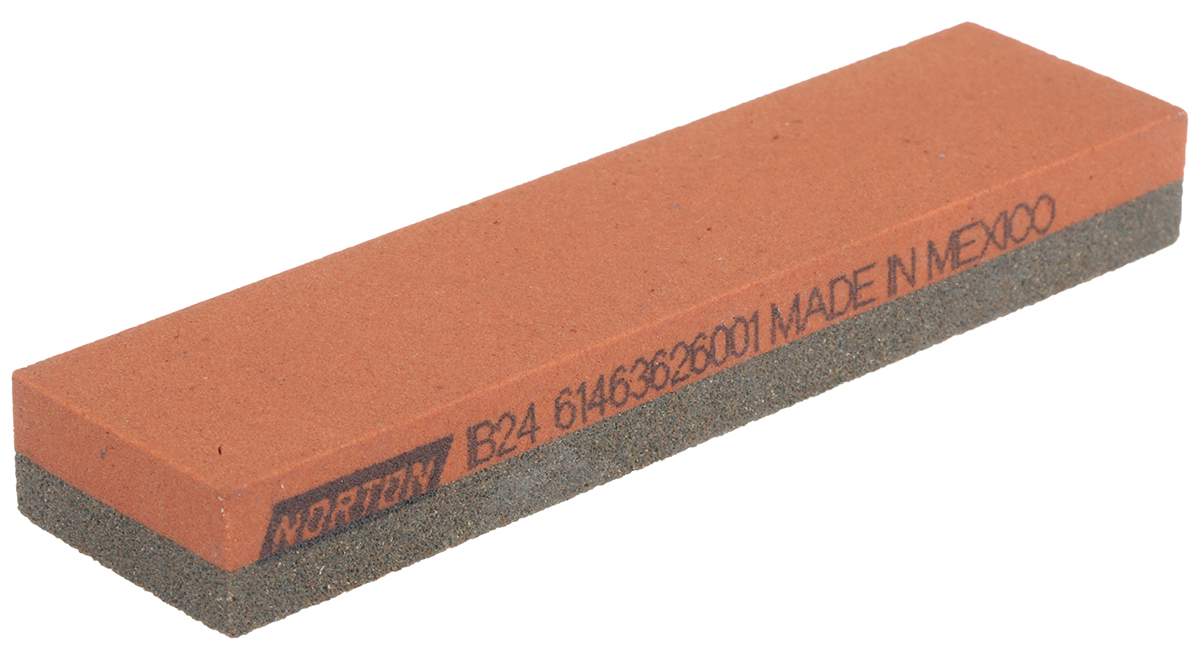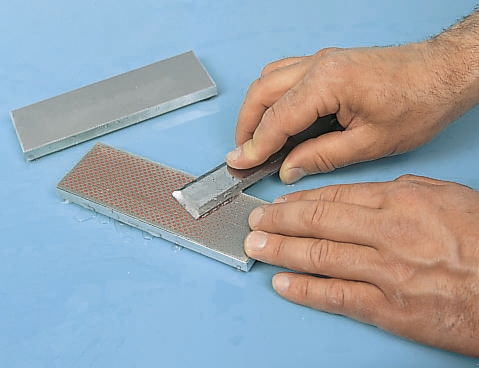Sharpening Stones - A Complete Guide
Our guide is here to help you understand what sharpening stones are used for and explain the different types.

What are Sharpening Stones?
Sharpening stones, also known as whetstones, are a simple, longstanding tool used to sharpen blades by grinding them against an abrasive surface. This process is known as ‘honing’.
They are made from a variety of natural and artificial materials with different levels of abrasion. Some sharpening stones, made from artificial abrasive, feature two sides - a coarser side for heavier work and a finer side for finishing.
Blade sharpening stones form part of a larger category of manual sanding and sharpening tools, which also includes abrasive blocks and hand pads.
What are They Used to Sharpen?
Sharpening stones are principally used with bladed steel tools. Examples include:
-
Kitchen knives
-
Scissors
-
Reusable razors
-
Chisels
-
Plane blades
Types of Sharpening Stone
As we saw above, whetstones are made from a number of different materials, each of which produces differing finishes on the surface to which they are applied.
Here are some of the most common categories:
Water Stones
The broad term ‘water stone’ refers to sharpening stones that work best with water as a lubricant for the sharpening process. Both artificial and natural stones fall into this category.
Japanese Sharpening Stones
Japanese sharpening stones are regarded as the highest quality natural stones available. They are made in the eponymous country from exceptionally fine silica-rich stone and have hundreds of years of craftsmanship behind them. As it is conventional to immerse them in water for up to an hour before use, they are often referred to as ‘Japanese water stones’.
Arkansas Stones
Arkansas stones are a variety of natural sharpening stone, made from novaculite, a variety of quartz with a high silicon dioxide content. These stones are typically mined in the Ouachita Mountains in the US state of Arkansas, hence their name.
Dry Sharpening Stones
Honing generates heat through abrasion, so it is common to lubricate sharpening stones prior to application. Lubrication accelerates the honing process and removes the fine debris produced by sharpening, known as ‘swarf’, preventing later scratches. However, lubrication is not essential and most sharpening stones can be used either wet or dry. Some types of sharpening stone - for example, ceramic and those made from industrial diamond - are typically used with no lubrication.

Oil Stones
Oil stones are natural sharpening stones that benefit from using oil for lubrication. This category includes stones made from 3 varieties of mineral: novaculite, aluminium oxide, and silicon carbide.
Sharpening Stone Grade
Sharpening stones are graded according to the size of their grit - the rough particles embedded within the stone.
There are five grades:
As you might expect, coarser stones are used for heavier work, such as reshaping damaged or nicked blades, while medium stones are better for pure sharpening work. Finer stones, meanwhile, are used to polish the blade after the more vigorous stages of the sharpening process have been completed.
As indicated above, some sharpening stones made from synthetic materials are provided with both a coarse and a finer side for maximum utility. The former can be used for dull, badly worn blades, before turning the stone for the polishing and finishing stages.
Grit Size
The grit size of different stones is indicated by a range of printed numbers, which are intended to indicate how smooth a finish they will produce; the lower the number, the coarser the finish. It’s worth noting that as a general rule, coarser stones are typically more brittle than finer ones.
However, you should also be aware that these numbers are only approximations and they do not have a clear relationship to the actual size of the embedded particles. The smoothness of the finish will depend on additional factors other than the size of the particles, including their shape, how exposed they are, their resistance to pressure, and their overall strength.
Some of the most common sizes are compared in the following chart, from the coarsest to the highest grit numbers:
|
|
Typical use for knives |
|
|
Reshaping a damaged blade |
|
|
Adding a rough edge to a blunt blade |
|
|
Adding a medium edge with some cutting power |
|
|
Creating a fine edge |
|
|
Creating a very fine edge |
|
|
Adding an extremely smooth, mirror-like finish to a blade |
Sharpening Stone Shapes
Sharpening stones come in four basic shapes:
Rectangular is the most common and is ideal for working broad, flat edges. Square stones are a good choice for fine finishes and small implements like keys. Triangular stones are best for fine work with small recesses, while round sharpening stones provide a curved surface for sharpening rounded tools like gouges and smoothing other fine blades with a curved shape.
How to Use a Sharpening Stone
Larger stone sharpeners, sometimes called ‘bench stones’, are designed to be used on a bench or desk while others, referred to as ‘pocket stones’, are smaller, finer and more portable. Typically, the latter are made from artificial materials.
If you plan to use a coarser stone for more vigorous work, it is a good idea to secure this in place so it will not slide. This will make it much easier to apply even pressure and maintain a consistent angle while sharpening your blade.
Immersion in water is the most common method of lubrication, particularly for artificial stones, but some users prefer to apply oil instead. It’s important to note that if you use oil, you must continue to use oil throughout the life of the sharpening stone as you cannot switch to water later on.
Some whetstones, such as Japanese water stones, should be immersed for up to an hour, although a briefer immersion will suffice for some of the more standard varieties.

Once your sharpening stone has been fully prepared, it is time to begin honing. Brush the blunt edge of the blade tool across the abrasive surface of the sharpening stone - typically in an even, slightly angled criss-cross motion. An angle of 15-20° is ideal. The higher the angle, the more durable the sharpened blade will be, while lower angles will result in a sharper but less durable edge.
Rest your fingers on the top of the blade during the grinding motion to keep the pressure even and consistent. Alternate each side of the blade and try to maintain a consistent angle while doing so to achieve the best results.
What is the Best Sharpening Stone?
Oil Stone vs Water Stone
These two conventional terms suggest that certain stones are best used with oil as a lubricating medium while others perform better with water. However, this is not the case as all sharpening stones can be used with either lubricant - or none. Of course, the use of water or oil can be beneficial, and lubrication helps to prolong the life of very fine, expensive varieties like Japanese water stones.
Natural Sharpening Stones vs Synthetic
Natural vs synthetic whetstones is perhaps the biggest binary when it comes to blade sharpening.
The natural sharpening properties of hard minerals like quartz have been known and appreciated for many years, but nowadays, the available options have been considerably expanded by the addition of artificial bonded abrasives like carborundum (silicon carbide) or corundum (aluminium oxide). These can cut more quickly than the natural alternatives but do not typically include very fine grits.
India Stone vs Arkansas Stone
India Stone is a widely used medium honing stone made from aluminium oxide. The term is actually a brand name owned by the Norton Adhesive Company. These whetstones have a distinctive orange and tan colouring.
Arkansas stone, by contrast, is a natural sharpening stone made from a variety of quartz, as explained above.
Ceramic Sharpening Stones vs Water Stones
As the name suggests, ceramic sharpening stones are an artificial variety made from a fused block of ceramic material like silicon carbide (ceramics are hard materials made via heating, which contain no metallic or organic material). Ceramic sharpening stones are very hard-wearing and are normally used dry with no lubrication. They are typically available with medium and fine grit sizes.
By contrast, water stones can be both artificial and natural in origin. As discussed above, water can be used for lubrication when sharpening with these stones and it will make the process easier, but it is not essential in most cases.
Popular Brands
3M
Browse sharpening stones from 3M and discover the most suitable product to meet your requirements. Shop online today.
Eze Lap
Sharpening stones from Eze Lap are high quality and durable. Browse the full range online today with RS Components.
Norton
Whether you are looking for a fine, medium or coarse sharpening stone, we stock an extensive range of Norton whetstones. Browse online today
RS Pro
Explore the full range of sharpening stones from our in-house brand, RS Pro, and discover the perfect whetstone for your application.